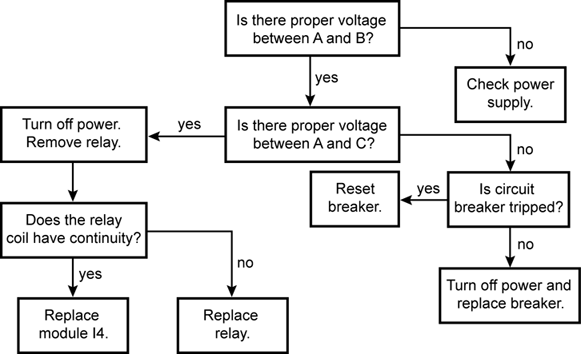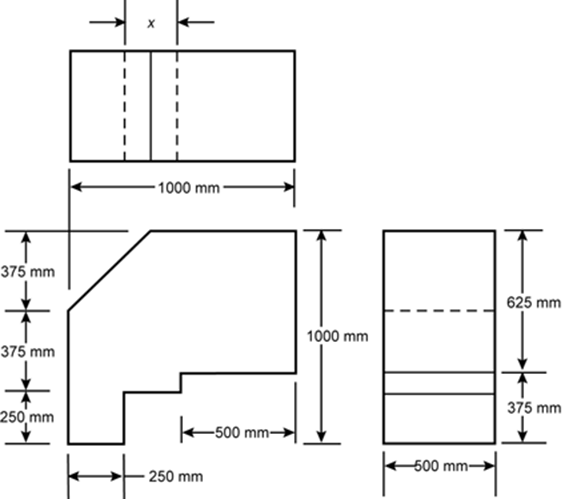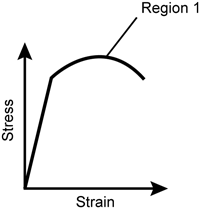Study Guide
Field 018: Engineering and Technology Education
Sample Multiple-Choice Questions
Objective 0001
Nature of Engineering and Technology (Standard 1)
1. A homeowner is required to obtain a building permit prior to the installation of a photovoltaic array on the roof of a house for which of the following reasons?
- providing data to the community about the use of alternative energy
- communicating information about the system to the local utility provider
- generating an architectural design for use by a general contractor
- ensuring that the equipment is compatible with the design of the existing structure
- Answer
-
Correct Response: D.
This question requires the examinee to demonstrate knowledge of the role of society and government in regulating and influencing engineering and technology. Residential buildings are designed to be structurally safe for their intended use. The addition of a photovoltaic array to the roof of an existing building is a change in intended use. This change may alter the load-bearing requirements of the existing structure due to both weight and wind-loading. In addition, the method of mounting the photovoltaic equipment must be done in a way that does not damage the roofing material in any way. Adherence to state and local requirements, along with permitting processes and inspections ensure that design and construction practices meet appropriate requirements.
Objective 0001
Nature of Engineering and Technology (Standard 1)
2. The decision to pursue possible new technology products or systems should be carefully analyzed because new technologies:
- often result in unintended consequences.
- may have limited applications.
- generally build on old technologies.
- often use nonrenewable resources.
- Answer
-
Correct Response: A.
This question requires the examinee to demonstrate knowledge of historical, cultural, political, societal, and economic contexts of engineering and technology. Technologies are developed to solve problems in order to meet a given want or need. New technologies often have profound social, environmental, or economic effects. Some of those effects may be predictable and well understood. However, new technologies may also produce effects that are unexpected and even undesirable. These effects, or unintended consequences, may have serious social, cultural, economic, or environmental ramifications. It is therefore essential to perform careful analysis in an effort to predict any unintended consequences.
Objective 0002
The Engineering Design Process (Standard 2)
3. A transportation engineer involved in designing a traffic light system for an intersection is most likely to conduct a vehicle count at the intersection during which of the following stages of the engineering design process?
- gathering information
- generating multiple solutions
- selecting an appropriate solution
- analyzing the solution
- Answer
-
Correct Response: A.
This question requires the examinee to demonstrate knowledge of the steps in the engineering design process. The design process is a systematic, iterative process. The first step involves identifying a need or a problem. Following that, engineers engage in the research phase of the project during which they collect data and/or review published material relating to the specific needs of their product or goal. Based on a review of this collection of information, the engineering design team proceeds to the next step of the design process.
Objective 0002
The Engineering Design Process (Standard 2)
4. Which of the following activities is most likely to be carried out in the research and development department of a steel manufacturing company?
- evaluating the cost-effectiveness of new equipment
- designing a just-in-time (JIT) system
- using X-rays to detect defects in steel products
- testing the tensile strength of a new steel alloy
- Answer
-
Correct Response: D.
This question requires the examinee to demonstrate knowledge of the role of research and development, innovation, and experimentation in technology systems. The research and development department of a company is generally where invention, innovation, and scientific investigations occur. In a steel company, engineers are likely to develop new products such as alloys. Testing the tensile strength of the new alloy would be an activity associated with research and development.
Objective 0002
The Engineering Design Process (Standard 2)
5. Use the flowchart below to answer the question that follows.

The flowchart is used to troubleshoot an electronic device. According to the flowchart, which of the following must be true if the relay needs to be replaced?
- The power supply is faulty.
- There is proper voltage between A and C.
- The circuit breaker is not tripped.
- Module I4 is functioning properly.
- Answer
-
Correct Response: B.
This question requires the examinee to demonstrate knowledge of troubleshooting technology systems. A troubleshooting flowchart is used by comparing the actual operation of a piece of equipment with the defined specifications. According to the flow chart, the following must be true if the relay needs to be replaced: there is proper voltage between A and B; there is proper voltage between A and C; the technician must turn off the power and remove the relay; and the relay coil can not have continuity.
Objective 0003
Energy Systems and Power Systems (Standard 3)
6. Use the diagram below to answer the question that follows.

The diagram represents a system that converts mechanical energy to electric energy, as shown in the diagram. Which of the following devices could represent the X?
- a gas turbine engine
- an internal combustion engine
- a wind-powered turbine
- a coal-powered steam engine
- Answer
-
Correct Response: C.
This question requires the examinee to demonstrate knowledge of processes and procedures used in energy and power systems. The block diagram represents an electrical generation system. The block labeled “X” indicates a device that has an input of mechanical energy and an output to an electric generator. Mechanical energy is associated with the motion of matter. A wind-powered turbine, consisting of rotating blades and a gear box, has an input of air (moving mass) and an output of a rotating shaft that could be connected to a generator.
Objective 0004
Communication Systems (Standard 4)
7. Use the diagram below to answer the question that follows.

In the orthographic drawing, what is the dimension labeled x?
- 125 mm
- 250 mm
- 375 mm
- 500 mm
- Answer
-
Correct Response: B.
This question requires the examinee to demonstrate knowledge of processes and procedures used in communication systems. The orthographic drawing provides the information required to determine dimensions of all segments of the object. Dimension X is illustrated with hidden lines and corresponds to the width of a raised region of the object. Region X is part of a linear dimension that has a total length of 1000 mm. Regions adjacent to X are labeled 250 mm and 500 mm respectively. The dimension associated with X is therefore 1000 mm – (500 mm + 250 mm) = 250 mm.
Objective 0005
Manufacturing Systems (Standard 6)
8. Use the diagram below to answer the question that follows.

The diagram shows a stress-strain graph for a cylindrical metal bar under tension. Which of the following best describes the properties of the metal in Region 1 of the graph?
- The metal is starting to experience shear stress.
- The metal is becoming more elastic.
- The metal is undergoing permanent deformation.
- The metal is starting to anneal.
- Answer
-
Correct Response: C.
This question requires the examinee to demonstrate knowledge of principles of science and engineering in manufacturing systems. Stress is defined as force per unit area (F/A). Strain is defined as the ratio of the change in length of a material to its original length (ΔL/L). In this graph, the region to the left of Region 1 illustrates a linear relationship between stress and strain. The metal bar changes in length proportionally to the applied stress and goes back to its original shape when the stress is removed. This is the elastic region. Region 1 illustrates a condition where small increases in stress results in a greater change of ΔL/L or elongation of the metal bar. When the stress is reduced, the elongation of the bar continues to increase. This is the plastic region where permanent deformation occurs.
Objective 0005
Manufacturing Systems (Standard 6)
9. Which of the following best describes how individuals on a marketing team are likely to work with engineers in a manufacturing enterprise?
- planning the type of system to use to manufacture the firm's products
- designing advertisements that explain the technical details of products
- converting customer needs and wants into new products
- developing surveys to gauge customer satisfaction
- Answer
-
Correct Response: C.
This question requires the examinee to demonstrate knowledge of tools, equipment, and materials used in manufacturing systems. Marketing serves as an interface between engineering and customers. A marketing team would use surveys, sales data, and focus groups to gather information relating customer satisfaction with existing products and their desire for new or modified models. The marketing team would translate this information into a range of ideas that could be utilized by an engineering team to improve existing products or design new products.
Objective 0006
Construction Systems (Standard 7)
10. Which of the following steps in residential construction generally occurs earliest in the process?
- rough electrical
- framing
- finish flooring
- roofing
- Answer
-
Correct Response: B.
This question requires the examinee to demonstrate knowledge of processes and procedures used in construction systems. The construction of a residential building takes place following a series of steps that are both time- and cost-efficient. Of the steps given, the framing occurs first because the framing of a building provides the structural component upon which others are completed. Both finish flooring and rough electrical work require an enclosed and weather-protected environment. Roofing requires the support provided by walls and rafters that are components of the framing.
Objective 0007
Transportation Systems (Standard 5)
11. Students in a technology engineering class design an experiment to test how material used to make tires interacts with different road surfaces. The students attach a sheet of the tire material to the bottom of a concrete cube. The students then measure the horizontal force needed to drag the cube across different surfaces at a constant velocity. This experiment would be most appropriate for investigating which of the following scientific concepts?
- angular momentum
- coefficient of friction
- conservation of mass
- energy transformation
- Answer
-
Correct Response: B.
This question requires the examinee to demonstrate knowledge of principles of science and engineering in transportation systems. The horizontal force needed to drag the cube across different surfaces at a constant speed is equal to the frictional force between the tire material and the road surface. Knowing the weight of the tire material and the concrete block allows for the determination of the coefficient of friction between the materials by finding the ratio of the frictional force to the object’s normal force, which in this case is equal to the weight of the tire material and the concrete block.
Objective 0007
Transportation Systems (Standard 5)
12. Which of the following is the primary benefit of using intermodal shipping containers for moving goods from the Midwest to China?
- Shipping containers do not need to be secured in transportation vehicles.
- Import tariffs are reduced for freight transported in closed containers.
- Goods are less likely to shift when transported in a shipping container.
- Loading and unloading can be accomplished without touching the actual freight.
- Answer
-
Correct Response: D.
This question requires the examinee to demonstrate knowledge of tools, equipment, and materials used in transportation systems. Intermodal shipping involves moving goods using some combination of air, ground, and water transportation. Intermodal shipping containers are standardized containers which are designed to be transported from origin to final destination without being opened. Standardization of the container sizes minimizes equipment needs and time when transferring from one mode to another. Shipping from the Midwest to a port city would typically take place via rail or truck. At the port, cranes would move the containers from rail cars or flat-bed trucks to a container ship. In this way, the freight is moved without being handled.
Objective 0008
Biotechnology Systems and Medical Systems (Standard 8)
13. The principles of diffusion and ultrafiltration across a semipermeable membrane are applied in which of the following biomedical procedures?
- dialysis
- magnetic resonance imaging
- tomography
- electroencephalography
- Answer
-
Correct Response: A.
This question requires the examinee to demonstrate knowledge of principles of science and engineering in biotechnology systems and medical systems and in biotechnology and medical products. A dialysis machine is designed to remove waste products from the blood. This process is effectively done by circulating the blood to be treated past membranes designed to remove unwanted material through a diffusion and osmosis filtration process using membrane material specifically designed for this purpose.
Objective 0009
Instruction and Assessment in Engineering and Technology Education (Standard 9)
14. A teacher would like to provide students with an engineering design project that promotes their understanding of the conversion of potential energy into kinetic energy. Which of the following projects is most appropriate for meeting this learning goal?
- designing a truss bridge that spans a given length and supports a given load
- designing a pneumatic arm that lifts an object and drops it into a container several feet away
- designing a tower that can withstand vibrations simulating the waves produced by an earthquake
- designing a small car that travels a given distance and is propelled by a standard mousetrap spring
- Answer
-
Correct Response: D.
This question requires the examinee to demonstrate knowledge of instructional strategies and resources for promoting students’ understanding of concepts and skills related to engineering and technology and their relationship to other academic fields. Potential energy refers to stored energy. Examples of potential energy include the gravitational energy of water contained behind a dam in a hydroelectric plant and the elastic energy stored in an elongated or compressed spring. Kinetic energy is energy of motion which can be calculated by knowing the mass and velocity of the object. When the mouse spring is compressed, the work done compressing the spring is stored as elastic potential energy. As the car begins to move, the potential energy in the spring is converted into the kinetic energy of the moving car.
Objective 0009
Instruction and Assessment in Engineering and Technology Education (Standard 9)
15. A technology teacher has students diagram the operation of a thermostat. This exercise is most appropriate for exploring which of the following Indiana Standards for Technology Education?
- Appropriately operate technological devices and systems.
- Select the appropriate devices and systems to meet personal and societal needs.
- Describe technology as a system with inputs, processes, outputs, and feedback.
- Define how technology helps improve, manage, and control the natural and human-made environments.
- Answer
-
Correct Response: C.
This question requires the examinee to demonstrate knowledge of the Indiana Academic Standards for Technology Education. A thermostat is designed to monitor the temperature of an environment and to produce some desired output. If the input (temperature) is too low, the thermostat will open a switch and send a signal to turn on a heating process. The thermostat continues to monitor the output of the process until the temperature reaches its set value, at which time the heating process is shut down. The process continues, thus maintaining a constant temperature. This is an example of a technological system with input, processes, outputs, and feedback. In this case, the temperature sensor and the switch connection to the on/off function of the system are acting as the feedback component.
